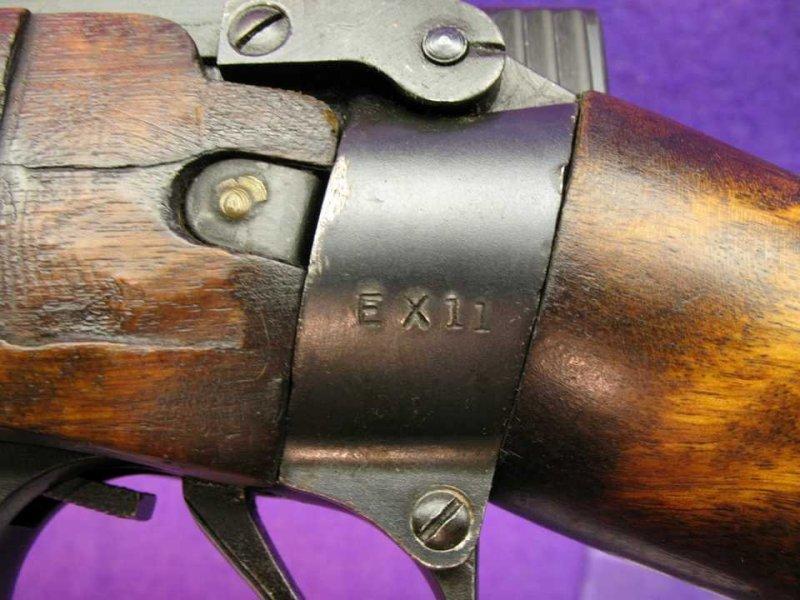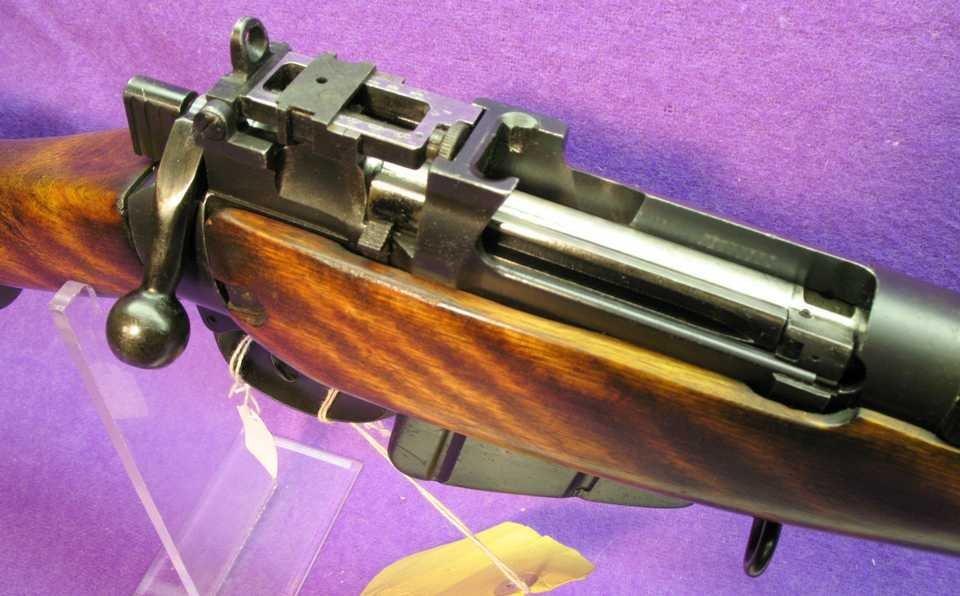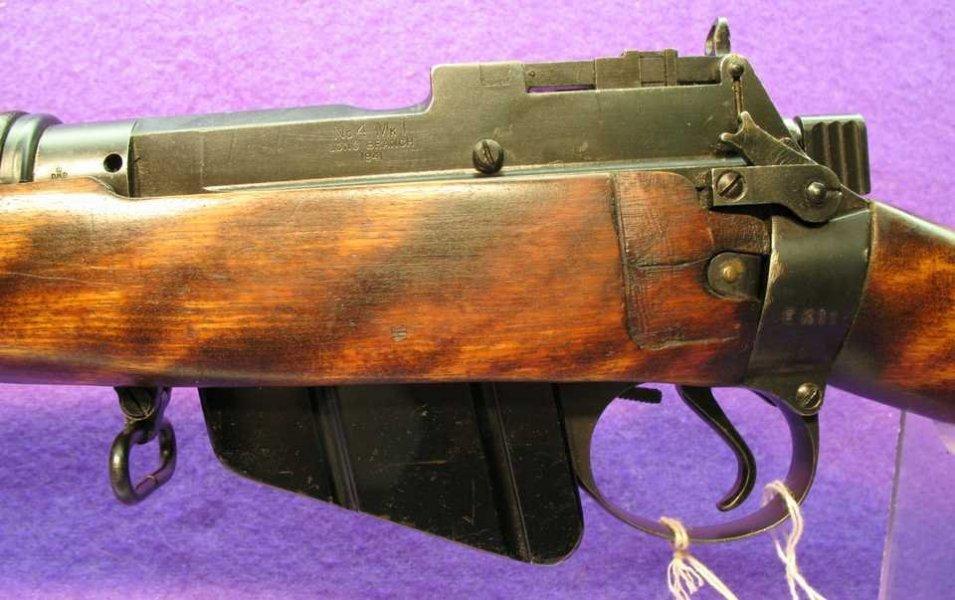-
 Long Branch Experimental Serial # EX2 ....
Long Branch Experimental Serial # EX2 ....
I have a friend who is a casual collector, but actually more of a shooter than anything else. He's got a small and varied collection, but he's had this rifle for a very long time. Although he's not a great photographer, he recently sent me some pics of it. After looking them over, I have requested he take off the wood and see if he can get me some pis of the barrel and other markings, if there are any.
I've been told by many, that we have one of the best Lee Enfield research forums on the Internet, so obviously this is a good place to start. I'd like some feedback from the more expert collectors amongst our highly knowledgeable community, as to what you think this is?
It's obviously a No.4 Mk1 profusely marked with with LB stamps throughout the parts, however, without the unique bolt removal notch near the breach, nor the typical "boot" looking safety. It's serial number is stamped EX2 and it appears to have a very early cocking piece and a brass butt plate. I also note the presence of a butt disc, which I've never seen on a Long Branch before, plus the bayonet lugs have been ground off.
Other than that, I can't tell much from the pics as I haven't handled the rifle, although my friend who lives in another city from us, will be making a pilgrimage down to visit and hopefully will be bringing the rifle, so I hope I can get a lot better images for everyone in the future.
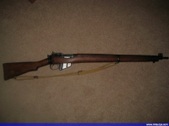 (Click PIC to Enlarge)
(Click PIC to Enlarge)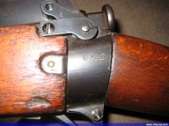
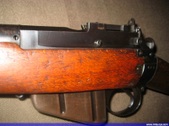 (Click PIC to Enlarge)
(Click PIC to Enlarge)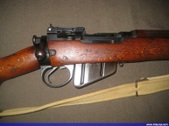
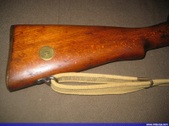 (Click PIC to Enlarge)
(Click PIC to Enlarge)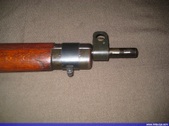
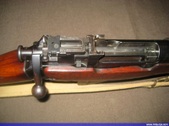 (Click PIC to Enlarge)
(Click PIC to Enlarge)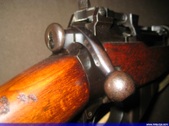
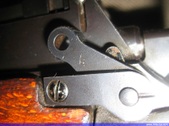
(Click PIC to Enlarge)
Any feedback would be welcome…. 
Regards,
Doug
Information
 |
Warning: This is a relatively older thread
This discussion is older than 360 days. Some information contained in it may no longer be current. |
|
Last edited by Badger; 05-25-2011 at 09:21 AM.
-
The Following 5 Members Say Thank You to Badger For This Useful Post:
-
05-25-2011 09:04 AM
# ADS
Friends and Sponsors

-
Advisory Panel


-
The Following 8 Members Say Thank You to Thunderbox For This Useful Post:
-
-
Advisory Panel


Just look at the lovely birch on EX11. It's obviously been set up as a target rifle at some point. That's why the buttstock has been extended, the forend relieved slightly and safety modified for the installation of a PH or AJP target sight. Were they experimental target variants? It's just a wild *** guess but makes sense.
-
Thank You to Brian Dick For This Useful Post:
-
Legacy Member

I think that that is the best looking Enfield stock I've ever seen. Beautiful. The relief on the left side of the stock wouldn't all be neccessary for a PH5C I don't think.
-
-
FREE MEMBER
NO Posting or PM's Allowed

Looks like the relief is for a Central plate
-
I wonder what exactly is 'experimental' about these two rifles. Are they simply very early, pre production 'testing the machinery' prototypes or some trials or just numbered factory samples to prove interchangeability or something similar or maybe factory 'patterns' or what we'd call 'blueprints' in engineering circles.............. Any ideas?
-
-
The one shown by Badger has an unusually fine finish on the action parts, but the butt socket doesn't appear to have been scrubbed clean before the application of the "E-X 2". Probably will have to see the various small markings in more detail to hazard any more guesses. The beech stock does seem somehow atypical, though.
Can't make out enough detail in the remaining photos on this computer to go much further at this point. Big screen on the 27th instant- hopefully!
-
-
FREE MEMBER
NO Posting or PM's Allowed

EX Rifles
Interesting. Here we have two rifles, hand stamped EX 2 and EX 11.
One would surmise that in 1941, production was geared into getting rifles into the hands of the Troops, and not Target Shooters.
When we think of the "EX", we tend to naturally think of "Experimental". However, I am going to throw a bone out there for thought.
What if the "EX" was to designate "Exhibition"?
During WW2, the Government had to raise funds and have support for the war effort. One of those ways was a travelling Exhibition that moved throughout the Country showing off the products of Canadian War Industry. This not only include Small Arms, but also vehicles, artillery and tanks mounted on and in railway cars. The train would stop at Towns and Villages, and the public could then tour through the cars and look at the larger stuff mounted on the flat cars behind. Of course, the War Bond people would be there to appeal to the Public for War Effort funds.
These Exhibitions would naturally have the showier pieces, with a bit better quality than the average wartime rifle. The "EX" prefix would give immediate identification of these rifles, and it could be that this particular series was not intended to be used on the Battlefield. Also, certain high ranking and influential people were personally presented with a rifle by the Government. Is it possible that the "EX" series was intended for Presentation rifles also? Or could these be "Pattern Room" type rifles, used for reference?
EX-11 has been modified for target work with a butt stock addition and a cut out for a target sight. But, I would be willing to bet a $100 bill that it never left the factory like that.
We learn a bit more about the Lee-Enfields every day. And today, unlike those previous times, there is more interest in History and the keeping of Records. In many cases, most of those old records that did exist have long been destroyed, so much of what we are learning today is a reconstruction of those times.
Exerpt from Newspaper Article in Hamilton, Ontario. Sorry, I could not copy some of the first and last sentences.
visited the Mulberry exhibition
during. the Hamilton showing,
which closed its doors on Saturday
night at 10 o'clock. This brings the
total attendance of -Mulberry visitors
to 275,000 since the opening in
Ottawa. Exhibitions have been
held in Montreal and Toronto, as
well as Ottawa and Hamilton, and
to-day, service personnel travelling
with the exhibit are busying themselves
packing up the model for
shipment to Winnipeg, the next
scheduled city on the itinerary.
At the close of the exhibition
Saturday 'night, Col . V. C. Steer-
Webster, O.S .E ., representative of
the British War Office who is touring
War Office who is touring
Canada with the exhibit, stated
with the exhibit, stated
that Hamiltonians had shown
more- interest in Mulberry than
had any other thus far. "The type
of questions asked," said the
colonel, "was of a high calibre and
showed an extreme interest in the
.
Last edited by buffdog; 05-26-2011 at 07:57 AM.
-
Advisory Panel


Interesting thread Buffdog. Could they have been built for some type of testing as Peter stated thouigh. I have a No.4, sn. EX2 in caliber 7.62 as done at Enfield. Skennerton thinks it's one of several built to test barrel twists for the L7 GPMG. It's a lovely rifle and has a .303 magazine cleverly modified internally to feed 7.62 rounds.
thinks it's one of several built to test barrel twists for the L7 GPMG. It's a lovely rifle and has a .303 magazine cleverly modified internally to feed 7.62 rounds.
Charlie is right about the PH 5C and AJP 4/47. They don't foul the forend and I stand corrected. EX11 is definitely shaved for a Central or possibly the PH 5A configured for the No.4. I have one here and got it out to look. I've never installed it for that very reason.
-
-
Advisory Panel


Possibilities would include trials of different woods for stocks as well, since one is in Birch and the other Beech. The first rifle apparently showing that Beech was in very early consideration; if the stock is original and it certainly looks like it is of that vintage, but it shows the kind of wear and tear you would expect on a well-used rifle, not a hardly used "experimental" piece. I don't think the stock is original myself, clearly sanded and refinished not long ago as well.
The EX11 rifle looks more like it might have been fitted up for someone on a left-over action with some carefully selected wood. Other examples like this are known, though usually built on un-numbered MkI* actions. Pity somebody carved up the forend to fit a Central Sight mounting plate!
I would guess that there were early actions made while the machinery was being set up and processes perfected, and they were probably made use of for furniture trials or exhibition or both, and any left overs or returned examples would have found new homes somewhere else in the years following, often via the employees or supervisors, getting restocked in the process.
Last edited by Surpmil; 10-02-2018 at 12:50 AM.
“There are invisible rulers who control the destinies of millions. It is not generally realized to what extent the words and actions of our most influential public men are dictated by shrewd persons operating behind the scenes.”
Edward Bernays, 1928
Much changes, much remains the same. 
-
(Click PIC to Enlarge)
(Click PIC to Enlarge)
(Click PIC to Enlarge)
(Click PIC to Enlarge)



















 PM
PM






